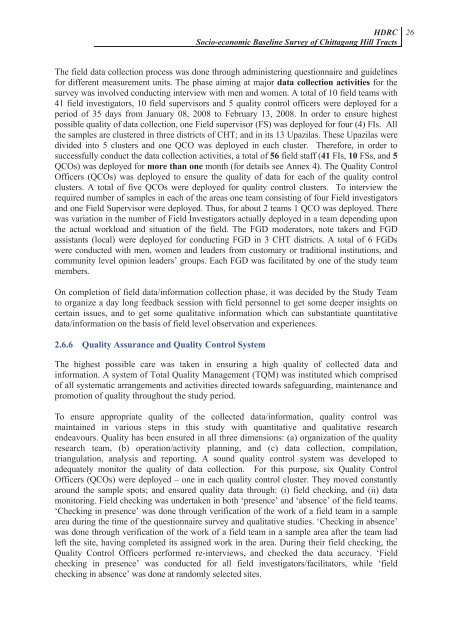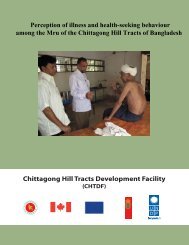Socio-economic Baseline Survey of Chittagong Hill Tracts - chtdf
Socio-economic Baseline Survey of Chittagong Hill Tracts - chtdf
Socio-economic Baseline Survey of Chittagong Hill Tracts - chtdf
- No tags were found...
Create successful ePaper yourself
Turn your PDF publications into a flip-book with our unique Google optimized e-Paper software.
HDRC<strong>Socio</strong>-<strong>economic</strong> <strong>Baseline</strong> <strong>Survey</strong> <strong>of</strong> <strong>Chittagong</strong> <strong>Hill</strong> <strong>Tracts</strong>26The field data collection process was done through administering questionnaire and guidelinesfor different measurement units. The phase aiming at major data collection activities for thesurvey was involved conducting interview with men and women. A total <strong>of</strong> 10 field teams with41 field investigators, 10 field supervisors and 5 quality control <strong>of</strong>ficers were deployed for aperiod <strong>of</strong> 35 days from January 08, 2008 to February 13, 2008. In order to ensure highestpossible quality <strong>of</strong> data collection, one Field supervisor (FS) was deployed for four (4) FIs. Allthe samples are clustered in three districts <strong>of</strong> CHT; and in its 13 Upazilas. These Upazilas weredivided into 5 clusters and one QCO was deployed in each cluster. Therefore, in order tosuccessfully conduct the data collection activities, a total <strong>of</strong> 56 field staff (41 FIs, 10 FSs, and 5QCOs) was deployed for more than one month (for details see Annex 4). The Quality ControlOfficers (QCOs) was deployed to ensure the quality <strong>of</strong> data for each <strong>of</strong> the quality controlclusters. A total <strong>of</strong> five QCOs were deployed for quality control clusters. To interview therequired number <strong>of</strong> samples in each <strong>of</strong> the areas one team consisting <strong>of</strong> four Field investigatorsand one Field Supervisor were deployed. Thus, for about 2 teams 1 QCO was deployed. Therewas variation in the number <strong>of</strong> Field Investigators actually deployed in a team depending uponthe actual workload and situation <strong>of</strong> the field. The FGD moderators, note takers and FGDassistants (local) were deployed for conducting FGD in 3 CHT districts. A total <strong>of</strong> 6 FGDswere conducted with men, women and leaders from customary or traditional institutions, andcommunity level opinion leaders’ groups. Each FGD was facilitated by one <strong>of</strong> the study teammembers.On completion <strong>of</strong> field data/information collection phase, it was decided by the Study Teamto organize a day long feedback session with field personnel to get some deeper insights oncertain issues, and to get some qualitative information which can substantiate quantitativedata/information on the basis <strong>of</strong> field level observation and experiences.2.6.6 Quality Assurance and Quality Control SystemThe highest possible care was taken in ensuring a high quality <strong>of</strong> collected data andinformation. A system <strong>of</strong> Total Quality Management (TQM) was instituted which comprised<strong>of</strong> all systematic arrangements and activities directed towards safeguarding, maintenance andpromotion <strong>of</strong> quality throughout the study period.To ensure appropriate quality <strong>of</strong> the collected data/information, quality control wasmaintained in various steps in this study with quantitative and qualitative researchendeavours. Quality has been ensured in all three dimensions: (a) organization <strong>of</strong> the qualityresearch team, (b) operation/activity planning, and (c) data collection, compilation,triangulation, analysis and reporting. A sound quality control system was developed toadequately monitor the quality <strong>of</strong> data collection. For this purpose, six Quality ControlOfficers (QCOs) were deployed – one in each quality control cluster. They moved constantlyaround the sample spots; and ensured quality data through: (i) field checking, and (ii) datamonitoring. Field checking was undertaken in both ‘presence’ and ‘absence’ <strong>of</strong> the field teams.‘Checking in presence’ was done through verification <strong>of</strong> the work <strong>of</strong> a field team in a samplearea during the time <strong>of</strong> the questionnaire survey and qualitative studies. ‘Checking in absence’was done through verification <strong>of</strong> the work <strong>of</strong> a field team in a sample area after the team hadleft the site, having completed its assigned work in the area. During their field checking, theQuality Control Officers performed re-interviews, and checked the data accuracy. ‘Fieldchecking in presence’ was conducted for all field investigators/facilitators, while ‘fieldchecking in absence’ was done at randomly selected sites.



